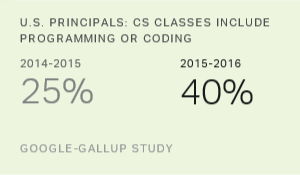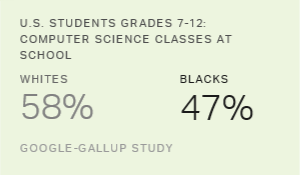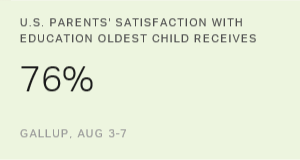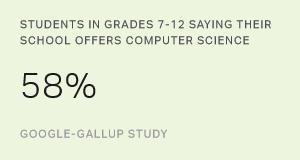Story Highlights
- 40% of principals say school offers CS classes with programming or coding
- 28% of parents, 30% of teachers have expressed support for CS classes
- Schools face barriers to implementing computer science classes
WASHINGTON, D.C. -- Forty percent of principals of K-12 schools in the U.S. report having at least one computer science (CS) class available in which students can learn computer programming or coding, according to Google and Gallup's study on computer science education. This is up from 25% a year earlier.
| Year 1 | Year 2 | ||||||||||||||||||||||||||||||||||||||||||||||||||||||||||||||||||||||||||||||||||||||||||||||||||
|---|---|---|---|---|---|---|---|---|---|---|---|---|---|---|---|---|---|---|---|---|---|---|---|---|---|---|---|---|---|---|---|---|---|---|---|---|---|---|---|---|---|---|---|---|---|---|---|---|---|---|---|---|---|---|---|---|---|---|---|---|---|---|---|---|---|---|---|---|---|---|---|---|---|---|---|---|---|---|---|---|---|---|---|---|---|---|---|---|---|---|---|---|---|---|---|---|---|---|---|
| % | % | ||||||||||||||||||||||||||||||||||||||||||||||||||||||||||||||||||||||||||||||||||||||||||||||||||
| Computer programming or coding to create things such as websites, apps or video games | 25 | 40 | |||||||||||||||||||||||||||||||||||||||||||||||||||||||||||||||||||||||||||||||||||||||||||||||||
| Robotics or artificial intelligence using programming/coding | 22 | 30 | |||||||||||||||||||||||||||||||||||||||||||||||||||||||||||||||||||||||||||||||||||||||||||||||||
| Using programming and coding to create computer graphics (slight wording change between years) | 29 | 26 | |||||||||||||||||||||||||||||||||||||||||||||||||||||||||||||||||||||||||||||||||||||||||||||||||
| Data analytics or visualization | 11 | 14 | |||||||||||||||||||||||||||||||||||||||||||||||||||||||||||||||||||||||||||||||||||||||||||||||||
| Year 1 and Year 2 refer to the two Google-Gallup studies; Year 2 Google-Gallup study conducted Dec. 3, 2015-Jan. 26, 2016. | |||||||||||||||||||||||||||||||||||||||||||||||||||||||||||||||||||||||||||||||||||||||||||||||||||
| Gallup | |||||||||||||||||||||||||||||||||||||||||||||||||||||||||||||||||||||||||||||||||||||||||||||||||||
When broader definitions of CS courses are considered, 60% of K-12 principals say their school offers at least one CS course. Seventy-six percent of principals overall and 88% of high school principals say some form of CS learning opportunities is available to their students, whether through classes, school-sponsored clubs or after-school activities.
These findings are from the second year of Google and Gallup's multiyear research effort to better understand perceptions of computer science and access to CS learning opportunities in K-12 schools in the U.S. Google and Gallup surveyed more than 16,000 seventh- to 12th-grade students; parents of seventh- to 12th-grade students; and K-12 teachers, principals and superintendents for the second year of this study. Full findings are available in the report Trends in the State of Computer Science in U.S. K-12 Schools.
About Three in 10 Parents and Teachers Request CS Education
Computer science classes are becoming more prevalent in schools. Part of the reason may be that parents and teachers are voicing a demand for these classes at their schools. Twenty-eight percent of parents of seventh- through 12th-grade students say they have personally expressed support for CS education to a school official, and 30% of teachers have done the same. In addition, a majority of principals (56%) and superintendents (62%) have expressed at least some support for CS to their superiors.
| Parents | Teachers | Principals | Superintendents | ||||||||||||||||||||||||||||||||||||||||||||||||||||||||||||||||||||||||||||||||||||||||||||||||
|---|---|---|---|---|---|---|---|---|---|---|---|---|---|---|---|---|---|---|---|---|---|---|---|---|---|---|---|---|---|---|---|---|---|---|---|---|---|---|---|---|---|---|---|---|---|---|---|---|---|---|---|---|---|---|---|---|---|---|---|---|---|---|---|---|---|---|---|---|---|---|---|---|---|---|---|---|---|---|---|---|---|---|---|---|---|---|---|---|---|---|---|---|---|---|---|---|---|---|---|
| % | % | % | % | ||||||||||||||||||||||||||||||||||||||||||||||||||||||||||||||||||||||||||||||||||||||||||||||||
| Expressed CS support to school officials | 28 | 30 | 56 | 62 | |||||||||||||||||||||||||||||||||||||||||||||||||||||||||||||||||||||||||||||||||||||||||||||||
| Google-Gallup study conducted Dec. 3, 2015-Jan. 26, 2016. | |||||||||||||||||||||||||||||||||||||||||||||||||||||||||||||||||||||||||||||||||||||||||||||||||||
| Gallup | |||||||||||||||||||||||||||||||||||||||||||||||||||||||||||||||||||||||||||||||||||||||||||||||||||
Despite the efforts of those who have expressed support for a computer science education, only one-third or fewer of principals and superintendents agree that CS is a top priority in their school or district. Principals at high schools, private schools and larger schools are more likely to agree that their school board is committed to offering a computer science education.
Lack of Resources a Barrier to Implementing CS Classes
School administrators face barriers to offering computer science in schools. When asked which potential reasons for not offering CS apply to their school, 63% of K-12 principals and 74% of superintendents currently not offering CS in their school or district say they lack teachers with the necessary skills to teach computer science curriculum.
Additionally, 55% of principals and 57% of superintendents say their school does not have enough money to hire or train a CS teacher, and 50% of teachers and 55% of superintendents note that they must devote most of their time to other courses related to testing requirements.
| Principals | Superintendents | ||||||||||||||||||||||||||||||||||||||||||||||||||||||||||||||||||||||||||||||||||||||||||||||||||
|---|---|---|---|---|---|---|---|---|---|---|---|---|---|---|---|---|---|---|---|---|---|---|---|---|---|---|---|---|---|---|---|---|---|---|---|---|---|---|---|---|---|---|---|---|---|---|---|---|---|---|---|---|---|---|---|---|---|---|---|---|---|---|---|---|---|---|---|---|---|---|---|---|---|---|---|---|---|---|---|---|---|---|---|---|---|---|---|---|---|---|---|---|---|---|---|---|---|---|---|
| % | % | ||||||||||||||||||||||||||||||||||||||||||||||||||||||||||||||||||||||||||||||||||||||||||||||||||
| No teachers available in their school with necessary skills to teach CS | 63 | 74 | |||||||||||||||||||||||||||||||||||||||||||||||||||||||||||||||||||||||||||||||||||||||||||||||||
| Not enough money to train or hire a CS teacher | 55 | 57 | |||||||||||||||||||||||||||||||||||||||||||||||||||||||||||||||||||||||||||||||||||||||||||||||||
| Devote most time to courses related to testing requirements | 50 | 55 | |||||||||||||||||||||||||||||||||||||||||||||||||||||||||||||||||||||||||||||||||||||||||||||||||
| Google-Gallup study conducted Dec. 3, 2015-Jan. 26, 2016. | |||||||||||||||||||||||||||||||||||||||||||||||||||||||||||||||||||||||||||||||||||||||||||||||||||
| Gallup | |||||||||||||||||||||||||||||||||||||||||||||||||||||||||||||||||||||||||||||||||||||||||||||||||||
Bottom Line
More schools are offering computer science to students than they did a year earlier. A higher percentage of principals now say their school offers CS educational opportunities, especially in key concepts such as coding and programming. Still, schools have plenty of opportunities to enhance their CS education further.
Twenty-eight percent of parents and 30% of teachers already are actively advocating for CS opportunities in school. To continue growing CS offerings in schools, more parents and teachers could urge school officials to bring CS education to the classroom. A majority of principals and superintendents also have voiced support for CS instruction, but they report that a lack of resources -- including qualified teachers and sufficient funding -- is a barrier to providing a computer science education.
While increasing CS offerings in schools can help more students view computer science as a viable career, encouraging student participation in the CS opportunities that are offered and increasing awareness of community-based and online CS learning opportunities could also boost students' exposure to and interest in CS. Many CS learning opportunities are available through private and public organizations. Increasing student and parent awareness of these resources would likely result in more students gaining these critical skills.
To learn about ways to increase CS learning for K-12 students, read the report Trends in the State of Computer Science in U.S. K-12 Schools.
Survey Methods
Results for this Google and Gallup student computer science education poll are based on interviews conducted Dec. 3, 2015, through Jan. 26, 2016, with more than 16,000 seventh- to 12th-grade students; parents of seventh- to 12th-grade students; and K-12 teachers, principals and superintendents in the U.S.
Telephone interviews were conducted with random samples of 1,672 students in grades seven to 12; 1,677 parents with at least one child in grades seven to 12; and 1,008 first- to 12th-grade teachers in all 50 states and the District of Columbia, based on samples drawn using the nationally representative Gallup Daily tracking recontact sample.
Web surveys were completed among representative samples of 9,805 K-12 school principals and 2,307 superintendents in the U.S. using a sample provided by established education sample providers.
For results based on the total sample of students, the margin of sampling error is ±3.4 percentage points at the 95% confidence level. The design effect is ±2.1 percentage points. For results based on the total sample of parents, the margin of sampling error is also ±3.4 percentage points at the 95% confidence level. The design effect is ±2.0 percentage points. For results based on the total sample of teachers the margin of sampling error is ±3.9 percentage points at the 95% confidence level, with a ±1.6 percentage point design effect. For results based on the total sample of principals, the margin of sampling error is ±1.0 percentage point at the 95% confidence level, while for results based on the total sample of superintendents, the margin of sampling error is ±2.7 percentage points at the 95% confidence level.
Learn more about the Google and Gallup partnership on computer science education research.





